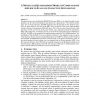241 search results - page 21 / 49 » Understanding Social Networks Using Formal Concept Analysis |
IPPS
1998
IEEE
13 years 11 months ago
1998
IEEE
The paper presents how the Random PROLOG Processor (RPP), a bio-inspired model of computations, can be used for formalization and analysis of a phenomenon - the Collective Intelli...
IJCNN
2007
IEEE
14 years 1 months ago
2007
IEEE
Learning by human tutelage means that a human being guides the attention of a robot or agent in order to teach it a given concept. This kind of learning is very important to devel...
CSCW
2012
ACM
12 years 3 months ago
2012
ACM
We report on a study of the English edition of Wikipedia in which we used a mixed methods approach to understand how nested organizational structures called WikiProjects support c...
SIGCOMM
2006
ACM
14 years 1 months ago
2006
ACM
Researchers have proposed a variety of metrics to measure important graph properties, for instance, in social, biological, and computer networks. Values for a particular graph met...
INFOCOM
2010
IEEE
13 years 6 months ago
2010
IEEE
—Delay Tolerant Networks (DTN) are networks of self-organizing wireless nodes, where end-to-end connectivity is intermittent. In these networks, forwarding decisions are generall...

